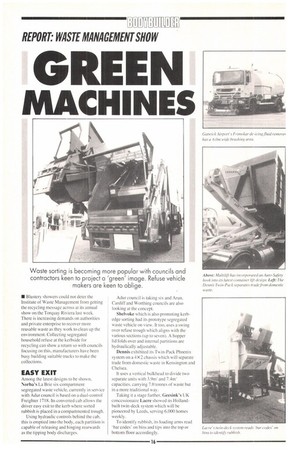GREEN
Page 100

If you've noticed an error in this article please click here to report it so we can fix it.
MACHINES Waste sorting is becoming more popular with councils and contractors keen to project a 'green' image. Refuse vehicle makers are keen to oblige.
• Blustery showers could not deter the Institute of Waste Management from getting the recycling message across at its annual show on the Torquay Riviera last week. There is increasing demands on authorities and private enterprise to recover more reusable waste as they work to clean up the environment. Collecting segregated household refuse at the kerbside for recycling can show a return so with councils focusing on this, manufacturers have been busy building suitable trucks to make the collections.
EASY EXIT
Amontz the lateNt tle:,ips to be shown. Norha's La Brie six-compartment segregated waste vehicle, currently in service with Adur council is based on a dual-control Freighter 1718. Its converted cab allows the driver easy exit to the kerb where sorted rubbish is placed in a compartmented trough.
Using hydraulic controls behind the cab. this is emptied into the body, each partition is capable of releasing and hinging rearwards as the tipping body discharges. Adur council is taking six and Arun. Cardiff and Worthing councils are also looking at the concept.
Shelvoke which is also promoting kerbedge sorting had its prototype segregated waste vehicle on view. It too, uses a swing over refuse trough which aligns with the various sections (up to seven). A hopper lid folds over and internal partitions ai. hydraulically adjustable.
Dennis exhibited its Twin-Pack Phoeni system on a 4X2 chassis which will separate trade from domestic waste in Kensington and Chelsea.
It uses a vertical bulkhead to divide two separate units with 3.9m and 7.4m' capacities. carrying 7.0 tonnes of waste but in a more traditional way.
Taking it a stage further. Geesink's UK concessionaire Lacre showed its Hollandbuilt twin-deck system which will he pioneered by Leeds. serving 6.000 homes weekly.
To identify rubbish, its loading arms read 'bar codes' on bins and tips into the top or bottom floor accordingly.












































































































